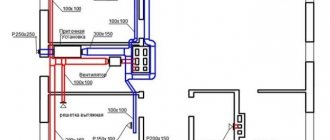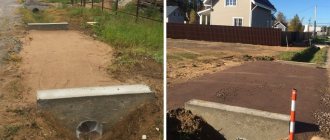Do you need your own stationary water supply system that can provide water to a private home all year round? Agree that it will be very disappointing to be left without water with the onset of cold weather, especially if there is a well in a suburban area that serves as a source of water intake.
Have you decided to make a winter water supply from a well on your own that will be suitable for use in any weather, but you don’t know the subtleties and nuances of this process?
We will help you understand all the features - the article provides the best methods and outlines the layout of an autonomous water supply system for year-round operation. The material is supplied with visual photographs.
The process of preparing the water supply system for winter is discussed step by step, including insulation of all important components. Useful video recommendations from experienced plumbers are provided.
Design features
Even a beginner can do everything with his own hands. The main thing is to correctly collect and analyze the source data. The cost of the materials used does not matter. The builder must ensure that they are suitable for the specific operating conditions. Regardless of the complexity of the system, prevention is carried out once every 3 months. Even under significant loads, the intensity of checks does not change. Payments for utilities will remain a significant expense item. We are talking about electricity used to power a submersible pump. These costs are recouped during the operation of the system.
In order for the entire system perfectly all winter, you need to choose the right components:
- Standard or submersible pump - it is recommended to install a deep-well type model;
- Frost-resistant pipes;
- Valve;
- Tap;
- Storage tanks, the volume of which is calculated taking into account the total load;
- Hydraulic accumulator;
- Cable for heating individual sections.
It is better to carry out plumbing in the warm season.
Hydraulic engineers note that the most difficulties arise at the stage of choosing a winter pump. You can only use an external pump if there is a minimum distance between the house and the well. If we are talking about 30 m or more, then in this case a hydraulic accumulator is used. Its task is to protect the pipeline from water hammer and power surges in the network.
Is it necessary to pump a well in winter?
Prolonged inactivity negatively affects the condition of the well. It begins to silt and the water quality deteriorates. For example, filter sand wells are very dependent on the intensity of operation (they silt up and fail quickly if they are not used in winter). It is recommended to pump them at least once a month for 20 – 30 minutes.
After the end of the winter period, it is important to properly restore the operation of the water intake, that is, pump up the well. The task is to lift layers of silt and sand from the bottom and squeeze them out of the pipe.
- We use the vibration method. We lower the vibration pump into the well and alternately, lowering and raising the apparatus, loosen the deposits at the bottom. We repeat the procedure until clean liquid arrives. We periodically clean the pump from dirt. We make sure that it does not sink to the bottom.
- Another version of rocking is carried out by pressing and throwing small particles of silt and sand that have accumulated at the bottom onto the surface. We use the method used in brine production wells, operating on the principle of “squeezing out brine.” We lower a smaller diameter pipe into the well until it stops at the bottom. We connect a hose to it from above, and let water through it with high pressure. The water jet squeezes out sediments and sand particles come to the surface. When gravel particles appear, we stop the process and remove the narrow pipe. We lower the pump and pump the water intake in the usual way. The disadvantage of this method is that the mesh filter may not withstand the pressure and break.
Insulation of the water supply system
Using this method, the pipeline is installed at a depth of 0.4-0.6 m, while it is insulated in the trench.
For the northern regions of Russia, it is recommended to line trenches with cellular concrete blocks or bricks. This approach will improve heat conservation. Implementation will require considerable financial investments, but this will eliminate 100% the likelihood of pipes freezing.
When constructing a water pipeline, two types of insulation are used:
- Soft thermal insulation materials.
- Rigid heat-saving shells.
When choosing a material, you need to pay attention to technical characteristics, resistance to mechanical and physical stress, cost, as well as ease of use.
Differences between winter and summer water supply
It seems to beginners that it is possible and necessary to leave the summer version of the aquifer system at the dacha. It is enough to strengthen it a little in order to enjoy the benefits of civilization all year round. The proposed scheme, according to hydraulic builders, will appear in all its glory in winter. As soon as the thermometer drops below -15 C, the savings will come to nothing.
Regardless of whether a mobile or permanent summer water supply is installed on the site, it can be used under favorable climatic conditions.
This is explained by many factors. The summer version, unlike the winter version, is laid at a shallow depth. As soon as the soil freezes, such a country water supply system will last a long time.
Unlike the summer pipeline, the winter pipeline must be properly insulated
If we talk about other factors, they look like this:
- The winter version is always mounted permanently;
- The system is insulated taking into account climatic conditions;
- It is necessary to install a heating cable if the climate is harsh;
- Bulk slag is used as an additional means of insulation.
Experienced builders do not recommend using the summer version of the system for winter use. The fallacy of such a decision can be understood after the first cold weather. Frozen soil will literally burst the pipes. No matter how much you insulate them, they won’t last long. It’s better to make a high-quality design for a home’s hot water supply system once. Subsequently, construction is carried out on its basis.
Water supply system conservation process
In order to avoid problems with the pipeline in the country, you should completely drain the water from the water supply system.
The whole point of the manipulations before leaving your own country house for the cold winter is as follows:
disconnect the pump from the system; drain the liquid from it and store the unit in a warm cellar; pump everything out of the pipeline by opening the valves on the lower branches of the system; if there are none, then remove and blow out the pipeline elements themselves; dry all plumbing fixtures, it is important that no moisture remains anywhere; Disconnect the dishwasher and washing machine and remove the water through the small drain hole. https://www.youtube.com/embed/CrZjMM0iL8Q
It is also necessary to preserve the street water supply, while pipes not dug into the ground must be thoroughly blown out with a compressor, and the fittings must be thoroughly dried. Remove the shut-off valves and remove all moisture; if removal is not possible, then simply leave the taps open and move the lever to the half-open position.
Pipe preservation
When preparing your dacha for winter, be sure to drain all appliances and preserve them. To do this, the water in the house is shut off and all electricity that powers the water heating elements is turned off and the liquid is drained from the toilet tank. It is imperative to check whether the outlet taps of the main water supply route are open.
To ensure that all moisture has been removed from the pipes, dry them using a compressor with a high air flow.
Well conservation
It is easy to properly preserve a well for the winter. After this procedure, it will be ready for work in the spring, and in winter it will not be used; access to liquid in the cold season will be completely blocked. After the water is drained from the heating units, the well is not in danger.
It is necessary to close the mouth: screw on the head that protects from precipitation and close it tightly with an airtight film
Preservation of a well at a summer cottage
In this case, you first need to isolate the entrance to the well shaft. This can be done using an insulated cap; it will reliably preserve the well and protect it from various climatic precipitations.
An excellent option for an insulated head is a log house with a flat roof made of iron sheets.
Option two: inside tap with extended switch
This scheme is more complex to implement, but no less effective. The point is that only one faucet is installed, and it will be located indoors.
PHOTO: bestlj.ruAnd in order to use it, the control knob must be brought out through the wall
If the walls are very thick, this is problematic.
PHOTO: bestlj.ru If not, then you can solve the problem not only by installing an extended switch, but also by installing an electromagnetic switch that will control the tap using a button from the outside
Which pipe is used to bury a water pipe?
When answering the question of how to make water supply from a well, you should pay attention to the depth of the system pipes. The depth to which pipes should be laid when organizing a water supply system for a site depends primarily on the latitude at which the dacha is located.
For example, in the conditions of the capital region, a depth of 1.6 meters is considered normal. This will be enough to ensure that the system does not freeze due to frost, which is possible in winter. At the same time, such a depth will also allow us to answer the question of how to conduct water from the well into the house, since there will be no need to think about possible freezing of the system.
If we take the regions of the south of the country, then the recommended depth for laying water pipes is 0.85 meters. In northern latitudes, experts recommend laying water pipes to a depth of no less than 2.75 meters.
Selecting a water supply source
In the process of designing a country water supply system, you need to choose the optimal source of water. Check out the available options and choose the one that best suits your case.
Centralized water supply
The simplest and most convenient option. It is important that the pressure in the system is sufficient to deliver water to the building. Otherwise, you will need to additionally buy a pump or consider other methods of water supply.
Water will be supplied to the building through a system of pipes and fittings.
In this case, to install a water supply system, you usually do not need to buy any additional devices - you simply need to dig a trench, lay down the water supply elements and cut into the central main line.
Centralized water supply at the dacha
If you are unable to connect to a central line, consider the following options.
Mine well
The method is suitable for areas with an underground aquifer depth of at least 8-10 m.
The well shaft is equipped with the efforts of 2-3 people - doing it alone is too long and difficult.
The main advantage of the option under consideration is the extreme simplicity of the system - you can maintain and repair it on your own. Maintaining such a well in good condition does not require significant costs.
The main disadvantage is the strictly limited water supply. Not every individual well can provide as much water as is necessary to satisfy all the needs of the family.
Water supply device from a well This is what a well looks like with a connected pipe and a lowered submersible pump
Before choosing this option, calculate the amount of water you need and determine how much water the well can produce.
The installation of a water supply system based on a shaft well requires the use of a surface pump. The equipment is relatively inexpensive and easy to maintain.
Surface pump for country water supply from a well Connecting a surface pump
Prices for a linear series of pumping stations
If the underground aquifer lies deeper than 8-10 m, you will have to drill a well. The pleasure is not cheap - drillers charge quite a significant amount of money for their work.
Water supply diagram from a well
But, having spent money once on installing a well, you will provide your dacha with clean water in the required volumes. If you want to save money, you can try to negotiate with your neighbors and make one well for several houses.
How to install water supply from a well
To install a water supply system in this case, you will need a special borehole or submersible pump. Such equipment is much more expensive than its surface counterparts, but in terms of efficiency in providing clean water, it has no equal.
The nuances of installing water supply from a well
Pipeline insulation
When supplying water to a private house from a well and a borehole, the pipeline can be laid at a very shallow depth - 40-50 cm - this is quite enough. Just laying pipes in such a shallow trench needs to be insulated. If you want to do everything thoroughly, then line the bottom and sides of the trench with some kind of building material - bricks or building blocks. Everything is covered with slabs on top.
An example of laying pipes above the freezing depth in a prepared ditch. The insulation of the water supply is carried out with a special insulation, with a suitable internal diameter
If desired, you can fill in the soil and plant annuals - if necessary, the soil can be easily removed and free access to the pipeline is provided.
Insulation for water pipes
Two types of insulation can be used:
- special energy-saving shells molded in the form of pipes, they are also called “pipe shells”;
- roll material - ordinary insulation in the form of rolls, which is used for walls, roofing, etc.
Thermal insulation for pipes in the form of a shell is made from the following materials:
- Expanded polystyrene - multiple granules are fused together. The result is a fairly rigid and durable material with good thermal insulation characteristics.
- Extruded polystyrene foam - the cells of the material have a closed structure (small balls). This also gives the material water-repellent properties, as well as higher thermal insulation properties. This is one of the best materials with a high degree of insulation, but its disadvantage is its high price.
- Polystyrene foam - one of the variants of expanded polystyrene - has good thermal insulation characteristics, but is characterized by low strength. That's why he needs protection - he can't stand pressure. But it costs a little. If you are laying pipes in a trench with walls made of brick or concrete, it can be used.
Recommended insulation for a well made of concrete rings
| Type of insulation | Features of the material | Installation technology |
| Styrofoam | Inexpensive, has good thermal conductivity, does not deform, and does not absorb water. Not resistant to rodents and insects. Sold in the form of ready-made elements corresponding to the sizes of reinforced concrete rings. | The walls of the well are cleaned of debris, façade glue is applied tightly, without gaps. Styrofoam is attached. If the foam does not adhere well, you can secure it with concrete dowel nails. Any barrier insulation material is laid on the foam. The trench is filled with earth and compacted. |
| Extruded polystyrene foam | Resistant to low temperatures, aggressive environments, and withstands loads well. Approximately 20% more expensive than polystyrene foam, produced in the form of slabs. | Installation is no different from installing foam plastic. The joints are sealed with polyurethane foam. The insulation is wrapped with rolled waterproofing material. |
We invite you to see how a member of our portal with the nickname pdp000 insulated his well
The insulation of the blind area is made of EPS, the walls of the ring are insulated with expanded clay. An insulated lid-liner is also made.
You can insulate a well with a little blood. Here are a few methods tested on FORUMHOUSE.
- Our user with the nickname Accurate covers the concrete ring of the ring with plastic film. Since then, the water supply pipe has not frozen even once - it was heated by well water, and the water did not freeze because the film did not allow the cold to pass through.
- Our participant with the nickname Hodok has been insulating a well from the inside for 40 years. Attach two frames made of thick wire in the form of inverted letters P to the last ring at a distance of 25 cm from each other. They descend to ground level. On them, Walker places two semicircles cut out of iron - this creates a flooring on which a plastic film is placed. He covers all the cracks with the same film, puts old clothes inside and leaves the well until spring. But this needs to be done when stable frosts arrive, so that the improvised insulation does not get wet from the fumes from the well.
New technologies in insulation
Current developments provide the opportunity to lay a winter water supply from a non-freezing pipe manufactured using modern innovations in a factory environment.
It looks like this:
- The material used is a flexible polymer, which avoids unnecessary connections;
- a special insulation is installed on its surface that meets modern quality requirements;
- on top of the insulating layer there is waterproofing that can limit the pipeline from unwanted moisture;
- A heating cable is provided along the pipeline to maintain positive temperatures.
Such pipes are intended for laying in northern regions in conditions of significant temperature drops. They are capable of operating at temperatures not lower than -40°C. They can withstand a working pressure of 1.0-1.6 MPa, which is quite enough for the needs of domestic water supply.
Such pipes are produced with a diameter of 25-110 mm, which allows for the transfer of large volumes of water or other liquid. They are sold in coils of the required length, which makes it possible to lay a pipeline from the point of water intake to the point of water use without docking.
As a new development on the construction market, liquid thermal insulation is introduced, which is applied to the outside of the pipeline in the form of paint and protects it from exposure to cold and moisture.
Video and diagram output
As you can see, the construction market offers a large number of special materials for thermal insulation of water pipes.
You can find modern solutions to this problem or use older developments that will cost much less. Take care in advance about the arrangement of the water supply and enjoy delicious drinking water in the winter cold!
Device requirements
A water heater for a country house is somewhat different from a device for a city apartment. A device intended for a summer residence must meet several basic requirements:
- Economical consumption of fuel or energy. You need to decide what is more practical and profitable for you - a wood-burning, gas or electric appliance.
- Suitable tank volume for family needs. For a country house, it is better to purchase devices with a small tank, because they are light and compact. But at the same time, it is necessary to calculate the daily consumption of hot water at the dacha.
- Correspondence of power to technical capabilities. It is worth consulting an electrician regarding the capabilities of your electrical wiring.
- Practicality and ease of use.
First you need to decide what energy the device will use to heat the water. At the dacha, you can use titanium on wood, a gas water heater or an electric appliance.
On this topic:
Installation and wiring of a water heater
Jun 17, 2017
Technical characteristics of the Gorenje FTGSMV6 water heater
Jun 17, 2017
BACK FORWARD 1 of 11
If you have autonomous heating, you can connect the water heater to the heating boiler.
In addition, you need to accurately determine the required volume of hot water and the heating time. The following main parameters are the geometric and technical properties of the device - its size and shape, efficiency and power. These criteria will affect the duration of water heating and energy consumption.
For example, for a large family, a storage water heater with a volume of about 200 liters will be convenient. For a small family, a small flow-through device will be suitable, which will heat the water very quickly.
Methods for installing winter water supply
To install a water supply system that will perform its main function - supplying water all year round, you must choose one of two options:
- Lay the water supply system so that the pipes run below the freezing depth of the soil.
- Lay pipes above the freezing horizon, but at the same time insulate them.
Both methods have their advantages and disadvantages. Let's look at them in more detail.
Below freezing depth
This method is advisable to use in cases where the freezing depth is no more than 150 cm. In this case, the value of the freezing depth is determined based on data for the last 10 years.
The installation of a water supply system begins with digging a trench of the required depth from the well to the point of entry of the water supply system into the house.
A 10 cm layer of sand is poured into the bottom of the trench and water pipes are laid. The trench is filled with earth, the soil at the backfill site is compacted.
Despite the fact that this is the simplest and most inexpensive way to create a winter water supply from a well, a problem arises with the choice of pipes: polyethylene pipes are not suitable here, because... will not withstand the mass of soil pressing from above, and metal pipes (steel) will corrode.
The problem can be solved by treating the pipes with an anti-corrosion compound before installation.
To lay a pipeline at great depths, thick-walled polyethylene pipes can be used, but they must be laid in a protective corrugated casing
In addition to the problem with choosing pipes, this method of installing winter water supply has several other disadvantages:
- when carrying out repair work, there is a need for a large volume of excavation work;
- difficulty in finding a damaged section of the pipeline;
- the likelihood of freezing and rupture of pipes in the water supply system in case of insufficient depth of the water supply system.
To reduce the number of accidents in the water supply to a minimum, it is recommended to make as few pipe joints as possible, because It is at the joints that leaks most often occur.
Also, when installing a winter water supply system below the seasonal freezing level, it is necessary to especially carefully monitor the tightness at the junction of the water supply pipes and the well.
When laying a pipeline below the seasonal freezing level, the trench is deepened to 20 - 30 cm to ensure the formation of a sand cushion of 15 cm and lay the pipes at the required depth
Insulation of water supply
With this method, the water supply is buried to a depth of 40-60 cm, but the pipes are laid insulated in the trench.
Of course, this will significantly increase the cost of building a winter water supply system, but it provides a 100% guarantee against freezing.
From above, such a trench is covered with concrete slabs and filled with soil. Pipes for installing insulated water supply systems usually use the most common ones: low-pressure polymer pipes of suitable diameter.
What insulation should I use? There are two options here:
- rigid heat-saving shells made of polystyrene foam or extruded polystyrene foam (“shell”);
- soft thermal insulation materials (foamed polyethylene versions, mineral and basalt wool with external water-repellent protection).
When choosing a thermal insulation material for pipes, you need to pay attention not only to its cost and ease of use, but also to its physical properties. For example, mineral wool is an inexpensive and easy-to-install insulation material, but it has high water-absorbing properties, which means it must be used with a mandatory vapor barrier layer.
For example, mineral wool is an inexpensive and easy-to-install insulation material, but it has high water-absorbing properties, which means it must be used with a mandatory vapor barrier layer.
Basalt wool based on sedimentary rocks is a fairly heavy insulation material that cannot be used for pipes of small diameter.
The choice of insulation should be made based on local conditions: soil moisture, freezing depth, and also taking into account the diameter and type of pipes
To backfill a trench with insulated pipes, it is best to use crushed stone or expanded clay rather than excavated soil.
These materials have a lower thermal conductivity coefficient than soil, and therefore will provide longer heat retention.
Heating
When planning the installation of winter water supply, you need to keep in mind that insulation only helps reduce heat loss, but cannot provide heat. And if at some point the frost turns out to be stronger, the pipe will freeze. Particularly problematic in this sense is the area where the pipe leads from the underground sewer into the house, even a heated one. Still, the soil near the foundation is often cold, and it is in this area that problems most often arise.
If you don't want to freeze your water supply, heat the pipe. For this, a heating cable or heating plates are used, depending on the diameter of the pipes and the required heating power. Cables can be laid lengthwise or wound in a spiral.
Method of attaching the heating cable to the water pipe (the cable should not lie on the ground)
A heating cable is good for everyone, but it’s not so rare that our electricity goes out for several days. What will happen to the pipeline then? The water will freeze and may burst the pipes. And repair work in the middle of winter is not the most pleasant experience. That’s why they combine several methods - they lay a heating cable and insulation on it. This method is also optimal from the point of view of minimizing costs: under thermal insulation, the heating cable will consume a minimum of electricity.
Another way to attach a heating cable. To reduce your electricity bills, you also need to install a heat-insulating shell on top or secure roll insulation
Laying a winter water supply system in a dacha can be done using the type of thermal insulation shown in the video (or you can take the idea and do something similar with your own hands).
The development of a scheme for laying a water supply system in a dacha is described here.
How to drain water correctly
So, so that in our absence at the dacha in winter the water does not freeze in the pipes and damage the plumbing and heating, our task is to completely drain it: From systems and appliances : we remove water from everything that is at risk of freezing, first of all - the supply water supply, heating system, water heating devices. Don't forget about the pump or pumping station, drain and expansion tanks and water filters.
From plumbing and household appliances : washing machine, shower. Experts advise leaving taps in the open or half-open position.
Advice from experienced people
Alisher Yakupov
The tips above really work and are used by many runners. For example, Alisher Yakupov advised wrapping a bottle in foil or wearing a small running backpack under a jacket, and also reminded that there are special thermal packs for drinking systems.
Denis Tkalich
Denis Tkalich, one of the authors of the blog “Run, Lifehacker, Run” and a future ultramarathon runner, advised drinking enough water throughout the day and drinking a glass immediately before running. In the future, he plans to take water with him on winter runs in a thermos.











